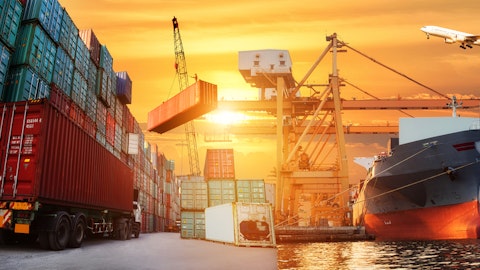Service centers drive what can be done over the long-term, but you got to have people and equipment as well. And we feel good about where we are with all elements of capacity and our ability to respond to growth when it comes to us, and it will. It’s just a matter of time before it comes. And so we’ll be ready when that time does come.
Kenneth Hoexter: Thanks, Adam. Appreciate it.
Operator: The next question is from Bascome Majors with Susquehanna. Please go ahead.
Bascome Majors: You talked earlier about starting to invest again in headcount and get ready for some of the growth that may come next year. Can you give us an update about where you are versus your capacity on facilities, people and equipment now? And any thoughts about where those constraints are showing up first, be it regionally or in functionally? Thank you.
Adam Satterfield: Yes. We’re – on the service center side, we’re at about 25% to 30% excess capacity. We’ll necessarily look at those other two pieces of the capacity equation in the same type of way. But our equipment, we’re in really good shape with where we are, probably a little bit heavy steel even with the influx of volume that we’ve seen over the last few months. But like I mentioned earlier, we’ll continue to go through and evaluate and optimize that as we look at what our 2024 CapEx plan might be. We’ve not formulated that at this point, and we’ll talk about it on the next earnings call. But what the fleet size should look like given whatever our baseline forecast for 2024 might be. And then we always look at kind of a bull case scenario and a bear case scenario as well to make sure that we’ve got an operating plan that can meet if we were to see really strong growth or the growth, not necessarily at the levels that our baseline indicated.
On the people side, obviously, we’ve been able to step up and meet the incremental volumes. Our people are getting more work, which I think makes them happy per se. And we had drivers that we’re working on the dock and combo type of roles. So we’re able to leverage that, putting those employees right back into a truck. And so overall, I think we’re in a really great spot with all elements. But it will require, as we get into next year, we do see some incremental growth from where we are now will require investment in our people. And that’s why we’ve restarted some of our truck driving schools, and we are hiring in certain locations as well for new drivers, employees on the platform that are moving the freight on their docks as well. So we will continue to add to the workforce, if you will, as we make our best efforts to match the capacity of our workforce with the shipment levels that we sort of see coming at us, but making sure that they’re on board ahead of the curve, so they’re properly trained especially on the dock that we make sure that we’re maximizing our load factor.
We’re using our claims prevention tools to keep that cargo claims ratio where it is at 0.1%, all those things are important. But you can’t just throw a person right into an environment where we’re growing double digits kind of thing. They’re just not going to be as efficient or as effective as we probably otherwise won’t. So we try to invest ahead of the curve, if you will, for that reason, to make sure that we get appropriate training in place before we really see the growth.
Bascome Majors: Thank you for that, Adam.
Operator: The next question is from Bruce Chan with Stifel. Please go ahead.
Bruce Chan: Thanks, operator, and good morning, everyone. Adam, maybe just want to follow-up on some of your comments on the commercial side. You’ve got a couple of competitors out there that are targeting that field accounts business. I want to ask you if you feel like you have the right mix of field national and 3PL at this point or things are kind of changing post Yellow. And then just quickly on the sales force, any additions that have happened there to maybe fill out the newer parts of the network and keep pushing on that share growth? Thank you.
Adam Satterfield: Yes, I feel like our – we’ve got a great sales team in place that national account team and local field sales that have been working hard over the last year in terms of continuing to build relationships, staying in front of our customers, letting them know that we’re here when they need us, and our team work hand in hand with our pricing and costing groups as well. And I think that, that coordination and symmetry that we have there, is evident when you look at our long-term success and our financial results. But we – about one-third of our business does come by way of 3PLs. We’ve actually seen a little bit of improvement there. In the third quarter, we had a little bit of growth with the accounts that are within that 3PL book of business just ever so slightly, but at least it was in the green when the overall book of business, the overall revenue was down 5.5% for the quarter, so that was good to see.
That was an area of weakness, in particular in the first quarter, where a few carriers, we’re putting some lower transaction type pricing in place. And I think that market firmed up pretty quickly in the end of July. So some of that business is starting to come back to us and hopefully, that can be a continuing trend as well. But we’ve got a great mix of our contract business and continue to grow with our small mom-and-pop accounts as well. And the 3PLs, we see opportunity within all of those categories really and our sales team will continue to leverage that and hopefully be ready for a good growth year in 2024.
Operator: The next question is from Stephanie Moore with Jefferies. Please go ahead.
Stephanie Moore: Hi. Good morning and thank you. I’ll keep it easy here and cheat and just essentially re-ask Amit’s first question. Given the 70s and change OR you saw in the current quarter and what is admittedly still a pretty weak freight environment. And also, I think you called out pretty well on this call, which is to spend your own kind of elevated expenses in 2023. Maybe just how the dynamics over the last couple of months change the timing of achieving that kind of six handle OR target just as you balance this obvious major industry events as well as your own kind of moderated growth and capacity investment strategy? Thanks.




